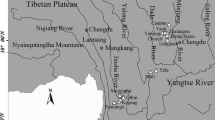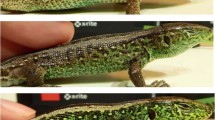Abstract
Sexual selection is often characterized by polygynous breeding systems, size dimorphism, and skewed operational sex ratios. Koalas are sexually dimorphic in multiple domains, yet are absent from the literature on sexual selection and the structure of their mating system is unclear. We provide the first documentation of the strength of sexual selection in koalas by using microsatellite markers to identify sires. We combine the genetic data with morphological data in order to assess the role of body size in regulating reproductive output. During our 4-year study, 37% of males were identified as possible sires. Males were significantly larger than females, with sires heavier than non-sires. Male body mass correlated with annual reproductive output, with Crow’s Index of Opportunity for Selection revealing that variation in male reproductive success was threefold higher than that of females. Since it appears that male koalas rarely engage in physical confrontations over access to females, size dimorphism could be based upon non-agonistic competition and/or female mate choice. We propose that size dimorphism in koalas evolved as a consequence of endurance rivalry promoting vocal sexual advertisements that attract females. We suggest that female choice is a key mediator of male reproductive output.

Similar content being viewed by others
References
Andersson M (1994) Sexual selection. Princeton University Press, Princeton
Bercovitch FB (1997) Reproductive strategies of rhesus macaques. Primates 38:247–263
Bercovitch FB (2007) Connecting conservation biology with evolutionary ecology: the case of the koala. Biodiversity 8:33–37
Bercovitch FB, Bashaw MJ, del Castillo SM (2006a) Sociosexual behavior, male mating tactics, and the reproductive cycle of giraffe, Giraffa camelopardalis. Horm Behav 50:314–321
Bercovitch FB, Tobey JR, Andrus CH, Doyle L (2006b) Mating patterns and reproductive success in captive koalas (Phascolarctos cinereus). J Zool 270:512–516
Breuer T, Robbins AM, Polejniczac C, Parnell RJ, Stokes EJ, Robbins MM (2010) Variance in the male reproductive success of western gorillas: acquiring females is just the beginning. Behav Ecol Sociobiol 64:515–528
Clutton-Brock TH (2004) What is sexual selection? In: Kappeler PM, van Schaik C (eds) Sexual selection in primates: new and comparative perspectives. Cambridge University Press, Cambridge, pp 24–36
Cornwallis CK, Uller T (2010) Towards and evolutionary ecology of sexual traits. TREE 25:145–152
Crow JF (1962) Population genetics. Am J Hum Genet 13:137–150
Darwin CR (1871) The descent of man and selection in relation to sex. John Murray, London
Derocher AE, Andersen M, Wiig O, Aars J (2010) Sexual dimorphism and the mating ecology of polar bears (Ursus maritimus) at Svalbard. Behav Ecol Sociobiol 64:939–946
Dique DS, Thompson J, Preece HJ, de Villiers DL, Carrick FN (2003) Dispersal patterns in a regional koala population in south-east Queensland. Wildl Res 30:281–290
Eberhard W (1996) Female control: sexual selection by cryptic female choice. Princeton University Press, Princeton
Ellefson JO (1968) Territorial behavior in the common white-handed gibbon, Hylobates lar Linn. In: Jay PC (ed) Primates: studies in adaptation and variability. Holt, Rinehart, & Winston, New York, pp 180–199
Ellis W, Carrick FN (1992) Total-body water and the estimation of fat in the koala (Phascolarctos cinereus). Aust Vet J 69:229–231
Ellis WAH, Melzer A, Green B, Newgrain K, Hindell MA, Carrick FN (1995) Seasonal variation in water flux, field metabolic rate and food consumption of free-ranging koalas (Phascolarctos cinereus). Aust J Zool 43:59–68
Ellis WA, Hale PT, Carrick F (2002) Breeding dynamics of koalas in open woodlands. Wildl Res 29:19–25
Ellis WAH, Melzer A, Bercovitch FB (2009) Spatiotemporal dynamics of habitat use by koalas: the checkerboard model. Behav Ecol Sociobiol 63:1181–1188
Ellis W, Bercovitch FB, FitzGibbon S, Melzer A, de Villiers D, Dique D (2010) Koala birth seasonality and sex ratios across multiple sites in Queensland, Australia. J Mammal 90:177–182
Ellis W, Bercovitch F, FitzGibbon S, Roe P, Wimmer J, Melzer A, Wilson RJ (2011) Koala bellows and their impact on the spatial dynamics of free ranging koalas. Behav Ecol (in press)
Gordon G, McGreevy DG, Lawrie BC (1990) Koala population turnover and male social organization. In: Lee AK, Handasyde KA, Sanson GD (eds) Biology of the koala. Surrey Beatty, Chipping Northon, pp 189–192
Haldane JBS (1932) The causes of evolution. Longman, London
Johnston SD, McGowan MR, Phillips NJ, O'Callaghan P (2000) Optimal physicochemical conditions for the manipulation and short-term preservation of koala (Phascolarctos cinereus) spermatozoa. J Reprod Fertil 118:273–281
Jones AG (2009) On the opportunity for sexual selection, the Bateman gradient and the maximum intensity of sexual selection. Evolution 63:1673–1684
Kamilar JM, Pokempner AA (2008) Does body mass dimorphism increase male–female dietary niche separation? A comparative study of primates. Behaviour 145:1211–1234
Krockenberger A (2003) Meeting the energy demands of reproduction in female koalas, Phascolarctos cinereus: evidence for energetic compensation. J Comp Physiol B Biochem Syst Environ Physiol 173:531–540
Le Boeuf BJ, Reiter J (1988) Lifetime reproductive success in northern elephant seals. In: Clutton-Brock TH (ed) Reproductive success. University of Chicago Press, Chicago, pp 344–362
Lee A, Martin R (1988) The koala, a natural history. University of New South Wales Press, Sydney
Lee KE, Seddon JM, Ellis WAH, Johnston SD, de Villiers DL, Preece HJ, Carrick FN (2010) Genetic variation and structuring in the threatened koala populations of Southeast Queensland. Conservat Genet 11:2091–2103
Martin R, Handasyde KA (1999) The Koala: natural history, conservation and management. University of New South Wales Press, Sydney
Mitchell P (1990a) The home ranges and social activity of koalas—a quantitative analysis. In: Lee AK, Handasyde KA, Sanson GD (eds) Biology of the Koala. Surrey Beatty and Sons, Sydney, pp 171–187
Mitchell P (1990b) Social behaviour and communication of koalas. In: Lee AK, Handasyde KA, Sanson GD (eds) Biology of the koala. Surrey Beatty and Sons, Sydney, pp 151–170
Mitchell P, Martin R (1990) The structure and dynamics of koala populations—French Island in perspective. In: Lee AK, Handasyde KA, Sanson GD (eds) Biology of the koala. Surrey Beatty, Chipping Norton, pp 97–108
Moore BD, Foley WJ (2005) Tree use by koalas in a chemically complex landscape. Nature 435:488–490
Pontzer H, Raichlen DA, Shumaker RW, Ocobock C, Wich SA (2010) Metabolic adaptation for low energy throuhput in orangutans. PNAS. doi:10.1073/pnas.1001031107
Ruckstuhl K, Neuhaus P (2006) Sexual segregation in vertebrates. Cambridge University Press, Cambridge
Schultz AH (1969) The life of primates. Weidenfeld and Nicolson, London
Selander R (1972) Sexual selection and sexual dimorphism in birds. In: Campbell B (ed) Sexual selection and the descent of man, 1871–1971. Aldine, Chicago, pp 180–230
Smith M (1980a) Behaviour of the koala, Phascolarctos cinereus (Goldfuss), in captivity. 3. Vocalizations. Wildl Res 7:13–24
Smith M (1980b) Behaviour of the koala, Phascolarctos cinereus (Goldfuss), in captivity. 5. Sexual behaviour. Wildl Res 7:41–51
Tobey JR, Andrus CH, Doyle L, Thompson VD, Bercovitch FB (2006) Maternal effort and joey growth in koalas (Phascolarctos cinereus). J Zool 268:423–431
Tobey JR, Nute TR, Bercovitch FB (2009) Age and seasonal changes in the semiochemicals of the sternal gland secretions of male koalas (Phascolarctos cinereus). Aust J Zool 57:111–118
Tucker GM (2009) Ecology, behaviour and growth of sub-adult koalas (Phascolarctos cinereus) on St Bees Island, Central Queensland. In: Centre for Environmental Management. Central Queensland University, Rockhampton, pp 285
Tucker GM, Melzer A, Ellis W (2007) The development of habitat selection by subadult koalas. Aust J Zool 55:285–289
Utami SA, van Hooff JARAM (2004) Alternative male reproductive strategies: male bimaturism in orangutans. In: Kappeler P, van Schaik C (eds) Sexual selection in primates. Cambridge University Press, Cambridge, pp 196–207
Vannoni E, McElligott AG (2009) Fallow bucks get hoarse: vocal fatigue as a possible signal to conspecifics. Anim Behav 78:3–10
Wade MJ, Arnold SJ (1980) The intensity of sexual selection in relation to male sexual behaviour, female choice, and sperm precedence. Anim Behav 28:446–461
Wade MJ (1987) Measuring sexual selection. In: Bradbury JW, Andersson MB (eds) Sexual selection: testing the alternatives. Chichester, New York, pp 197–207
Wade MJ, Shuster SM (2004) Sexual selection: harem size and the variance in male reproductive success. Am Nat 164:E83–E89
Wells KD (2001) The energetic cost of calling in tree frogs. In: Ryan MJ (ed) Anuran communication. Smithsonian Institution Press, Washington, DC, pp 45–60
Wells KD, Schwartz JJ (2006) The behavioural ecology of anuran communication. In: Narins PM, Feng AS, Fay RR, Popper AK (eds) Hearing and sound communication in amphibians. Springer, New York, pp 44–86
Acknowledgments
This study could not have been completed without the valuable input of Sean FitzGibbon and Alistair Melzer, both of whom contributed data and ideas to this report. The project was funded by The Earthwatch Organization and The San Diego Zoo Institute for Conservation Research. Field work was supported by Queensland Marine Parks Mackay. Kristen Lee oversaw all genetic analyses. Delma Clifton, Gail Tucker, Steve Burke, and Steve Fisher assisted with fieldwork. Queensland Department of Environmental and Resource Management provided the permits to work with koalas (WISP00491302), and the project was carried out under The University of Queensland animal ethics permit (ZOO/ENT/115/04/RT) and approved by the Institutional Animal Care and Use Committee of the Zoological Society of San Diego.
Author information
Authors and Affiliations
Corresponding author
Additional information
Communicated by F. Trillmich
Rights and permissions
About this article
Cite this article
Ellis, W.A.H., Bercovitch, F.B. Body size and sexual selection in the koala. Behav Ecol Sociobiol 65, 1229–1235 (2011). https://doi.org/10.1007/s00265-010-1136-4
Received:
Revised:
Accepted:
Published:
Issue Date:
DOI: https://doi.org/10.1007/s00265-010-1136-4




